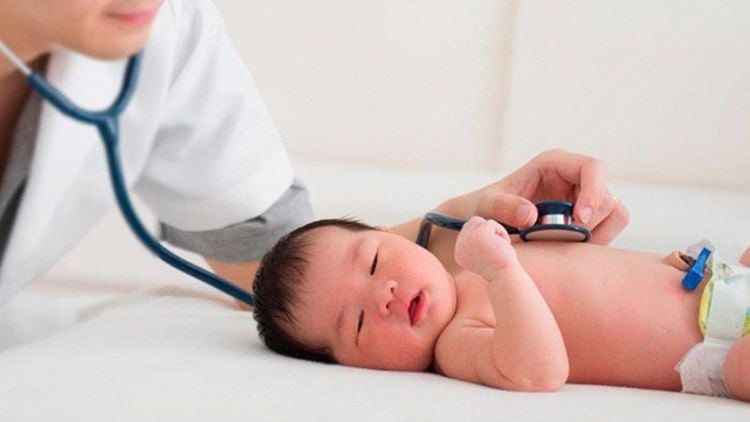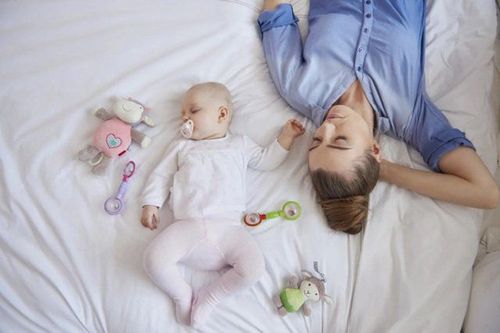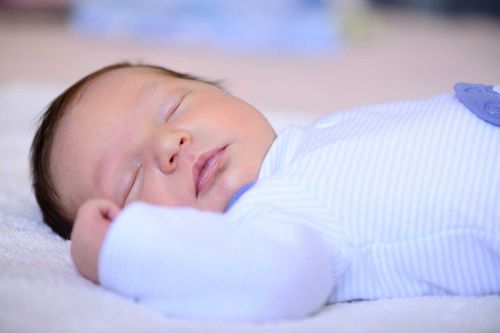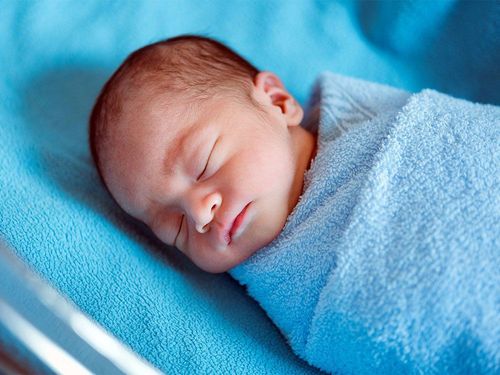This is an automatically translated article.
The article was consulted with Specialist II Chung Thi Mong Thuy - Pediatrician - Neonatologist - Department of Pediatrics - Neonatal, Vinmec Central Park International General Hospital.Sudden infant death (SIDS) is the sudden, unexplained death of a child under 1 year of age. Approximately 2,300 children die suddenly each year in the United States. In which, the majority of deaths are related to sleep.
1. What is Sudden Infant Death Syndrome (SIDS)?
Sudden infant death (SIDS) is a diagnosis given when a child under 1 year of age dies suddenly without an identifiable cause after a crime scene, autopsy, and medical history review.SIDS commonly occurs during or around sleep and deaths are due to accidental suffocation, strangulation, or unknown cause.
Sudden infant death (SIDS) is also known as “crib death” because it most commonly occurs at night, from 8pm to 8am.
2. Causes of sudden infant death (SIDS)
The cause of sudden infant death (SIDS) is still unknown. Most experts think that SIDS occurs when blood oxygen levels are low, and Co2 is elevated in babies with underlying damage such as abnormal heart function or an immature heart structure, breathing problems, and other conditions. breathing, sleeping on the stomach, smoking parents, premature babies, low birth weight babies or mothers who don't get prenatal care...Recent studies show that not enough serotonin in the brain can increase the risk infants with SIDS. Experts found that up to 70 percent of babies who died suddenly had low levels of serotonin in the brain stem. Serotonin helps regulate breathing, heart rate, and blood pressure during sleep.
Experts are continuing to study the brain, autonomic nervous system, care environment and sleep safety, infection and immunity, genetics to find answers.

SIDS xảy ra ở những em bé có các tổn thương tiềm ẩn như chức năng tim bất thường
3. Factors that increase the risk of sudden infant death (SIDS)
Premature birth: The earlier a baby is born, the higher the risk of sudden death (SIDS). Low birth weight: The lower the birth weight, the higher the risk of SIDS. The baby is less than 4 months old. Are boys: About 60% of SIDS victims are boys. Twins: The risk of SIDS is 2 times higher than that of the general population, largely due to the lower birth weight of twins. Mothers under 20 years old. The mother smoked during pregnancy. Short interval between pregnancies. Having family members die from SIDS. Ethnic origin: Sudden death rates are higher in Native American/Alaska black, non-Hispanic black infants. This is linked to practical infant care skills such as a preference for bed-sharing or tummy-to-sleep.4. Why does sharing a bed with a child increase the risk of sudden death (SIDS) and other sleep-related hazards?
Beds have soft items such as pillows and cushions, which are factors that increase the risk of sudden infant death syndrome (SIDS). Co-sleeping also increases the baby's body temperature. Therefore, in case the mother is breastfeeding in bed and is afraid to oversleep, remove the mattress from the pillowcase and bed.In addition, a number of other factors also increase the risk of SIDS in infants when sharing a bed with parents such as:
Putting the baby in bed with a tired parent or using drugs that induce sleep Put your baby in bed with a smoking parent, even if they don't smoke in bed Put baby in bed with an alcoholic parent Put baby in bed with a drug user Put baby in bed with people other than parents, including All other children Put baby in bed with more than 2 people

Ngủ chung giường với trẻ lại làm tăng nguy cơ đột tử
5. How can the risk of sudden death (SIDS) and other sleep-related hazards be reduced?
Families can reduce their risk of sudden infant death syndrome (SIDS) by following these sleep safety recommendations from the American Academy of Pediatrics (AAP):5.1. Put baby to sleep on back
The American Academy of Pediatrics AAP recommended that infants sleep on their backs in 1992. The risk of SIDS in infants is 2 to 13 times higher (depending on the study) if the baby is on their stomach instead of on their back. Because babies sleep on their stomachs increases the risk of excessive hyperthermia, apnea, decreased oxygen supply, and increased re-inhalation of exhaled CO2 for respiration.Recommendations:
Make sure all caregivers are aware of this Do not put your baby to sleep on their side: Babies on their side can be easily transitioned to a tummy position. Don't use towels or other devices to secure your baby to his or her back: The Food and Drug Administration (FDA) and the Consumer Product Safety Commission (CPSC) have issued warnings for parents to stop using sleep restraints after 12 infants suffocated while using these devices. When the baby is strong enough to roll on his own, the family should avoid worrying about the baby having to lie on his back all night. But continue to put your baby to bed on his back until he's 1 year old.
5.2. Do not share a bed with your baby
Sharing a bed with your baby increases the risk of sudden death (SIDS) from suffocation, strangulation, or strangulation. Babies should sleep in the same room but not as their parents at night for at least the first 6 months and ideally for the first year.Placing the bassinet near the bed allows mothers easy access for nighttime feeding and comforting. According to the AAP, this can halve the risk of sudden SIDS death.)
5.3. Firm bed surface, no mattress and soft pillow
Families should put the baby to sleep in a firm crib, with only a well-fitting sheet and a thin mattress underneath to waterproof the diaper.Do not place your baby on a soft mattress such as a neoprene mattress because it increases the risk of suffocation in the prone position. If putting your baby to sleep in a crib, use only the mattress that comes with it, without covering any other mattress. Do not place a mattress around the crib as it can cause suffocation, obstruct air circulation and make it difficult to see your baby. Furthermore, there is no evidence that they protect children from bumps and injuries. Do not cover your baby with blankets and pillows in any way because they can cover the face and obstruct breathing. If your baby is cold, dress him or her in warm clothing, such as a sleeping bag with legs, tuck him in cotton cloths, or wrap him in a blanket.
5.4. Avoid letting your baby sleep on the couch, armchair, or any other soft surface
Devices with soft surfaces increase the risk of sudden infant death syndrome (SIDS) and suffocation in infants. It is safer to put your baby in a bed that has removed items such as blankets and pillows. If you accidentally fall asleep in bed with your baby, put your baby back in the crib as soon as you wake up.5.5. Do not let your baby sleep in positions that can affect breathing
Families should not let children sleep on their side because it can cause airway obstruction, preventing the baby from breathing properly.The safest sleeping position for babies is on their backs because it helps keep the airways open. Your baby will not choke or vomit when lying on his back, even if he has gastroesophageal reflux disease. Don't let your baby sleep on a seating device including a car seat, stroller, swing or booster seat for long periods of time. Do not put the baby to sleep on his side. Especially for babies under 4 months old because babies can suffocate. If your baby falls asleep in the seat device, move him or her into the crib as soon as possible. When your baby is in the crib, make sure his head is on top of the fabric and his face, nose and mouth can be seen, is clear and not pressed against your body or the fabric surface. Do not raise your baby's mattress to reduce the risk of reflux and suffocation as your baby can slide or roll down.

Không nên để trẻ ngủ nghiêng vì có thể gây tắc nghẽn đường thở
5.6. Avoid letting your baby get too hot
A baby's body heat is a risk factor for SIDS. To prevent it, you should do:In the same environment, dress your child in no more than one layer as an adult. Watch out for signs when your baby is overheated such as sweating, wet hair or touching your chest. hot. Do not cover your head or wear a hood while your baby is sleeping.
5.7. Get regular prenatal care
Regular prenatal care reduces the risk of sudden infant death syndrome (SIDS). Taking the right care is not only important in ensuring a smooth pregnancy, but it also helps protect the baby's health by reducing the risk of preterm birth or low birth weight (both of which are risk factors for SIDS). ).5.8. Make sure your baby is vaccinated with all vaccines
There is ample evidence that adequate vaccinations protect children against SIDS.5.9. Breastfeed when possible
The more breast milk a baby is breastfed, the greater its protection against SIDS. Studies show that babies who are breastfed for at least 2 months cut their risk of SIDS in half even if not exclusively breastfed. Therefore, mothers should breastfeed their babies for more than 2 months to protect their babies from SIDS.5.10. Give your baby a pacifier at bedtime
Rates of SIDS are lower in infants using pacifiers. Therefore, families should give the baby a pacifier before going to bed for the first year of life. A pacifier should only be given to a baby after 3-4 weeks of age, when the baby's suckling ability has matured. There is no need to reinstall the pacifier if your baby drops it while sleeping. And do not force use when the baby does not want. Note: To avoid strangulation, do not hang a pacifier around your baby's neck or attach it to clothing while your baby is sleeping.6. Should babies sleep in cribs?
Babies should sleep in a crib, crib, or play yard that meets current safety standards and is placed in a room close to the parent's bed.Do not use any seating device as a substitute for a crib. If your baby falls asleep in a car seat, stroller, stroller, or swing, move him or her into a bassinet, crib, or play yard as soon as possible. Consider bringing a portable crib or play yard if the family is taking the kids out. Do not use a side bed, whether the bed meets CPSC safety standards.

Em bé nên ngủ trong nôi, cũi được đặt trong phòng gần với giường bố mẹ.
7. Can sleeping twins sleep together?
Twins cannot sleep together. Studies have shown that sharing a bed with other children puts babies at a higher risk of sudden infant death syndrome (SIDS). This risk can come from factors such as preterm birth and low birth weight.8. Is it okay to wrap a baby in a towel?
When swaddling your baby tries to get out of the swaddle, you should stop. In this situation, the baby is at risk of having his or her face covered or suffocating in the face down position. In addition, when wrapped in a towel, the baby's body temperature can rise. So when wrapping a towel, make sure to use a thin blanket and that the room is not too hot.9. Should a heart rate monitor be used to prevent sudden infant death syndrome (SIDS)?
Heart rate monitors are not intended for use with the purpose of preventing sudden infant death syndrome (SIDS). In some cases, it is indicated for babies who have been diagnosed with sleep apnea or bradycardia.In addition, in order to prevent diseases that babies often get, parents should pay attention to nutrition to improve children's resistance. At the same time, add supporting foods containing lysine, essential micro-minerals and vitamins such as zinc, chromium, selenium, B vitamins,... snacks and less digestive problems.
Parents can learn more:
Why do you need to supplement Lysine for your baby?
The role of zinc - Guidelines for reasonable zinc supplementation
Please visit the website Vinmec.com regularly and update useful information to take care of your baby and family.
Reference source: babycenter.com














